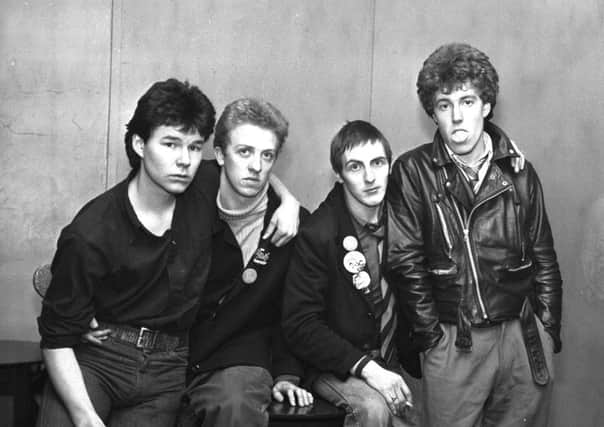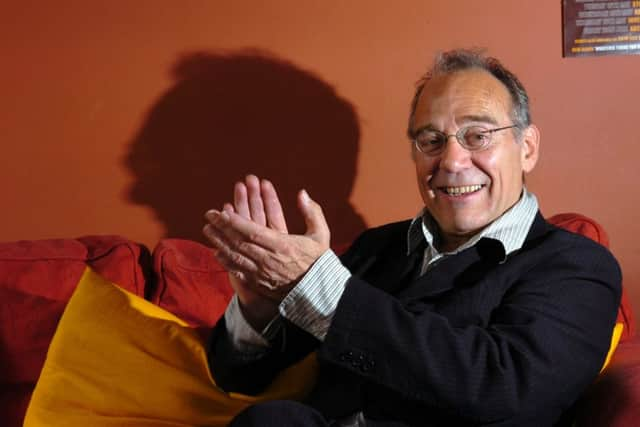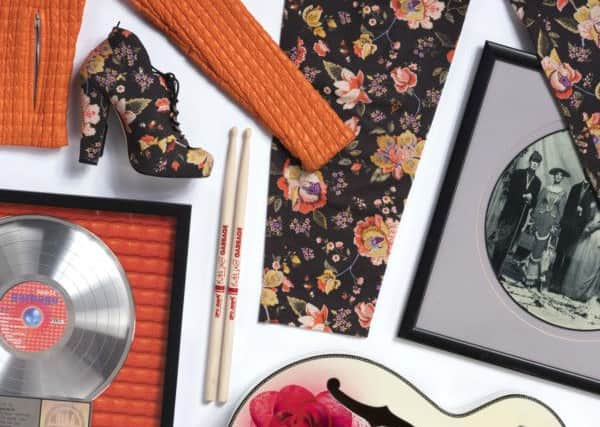Scotland's pop and rock heritage takes centre stage at exhibition


It will feature around 300 objects from more than 50 acts spanning seven decades – as Scotland’s pop and rock heritage finally takes centre stage in its first major exhibition.
The origins, appeal, image and impact of the nation’s best-loved bands and singers are about to be celebrated at the National Museum of Scotland in Edinburgh.
Advertisement
Hide AdRare artefacts and personal memorabilia linked to The Bay City Rollers, The Proclaimers, Deacon Blue, Simple Minds, Garbage and Belle & Sebastian have all been unearthed for the five-month exhibition.


It will also explore the influence of ground-breaking artists like the Incredible String Band, The Rezillos, The Skids, the Sensational Alex Harvey Band, The Fire Engines and The Beta Band, and the underground scenes they emerged from.
Three years in the planning, the exhibition is one of the most complex ever staged by the museum due to the huge range of sources for exhibits – many of which have come on loan from the artists themselves.
Band managers, agents, record shop owners, promoters, academics and broadcasters have all worked with the museum on the exhibition, which will be accompanied by a three-part TV series and a four-part radio series (both for BBC Scotland), as well as an official Rip It Up book, by broadcaster Vic Galloway.
Original costumes, instruments, handwritten song lyrics and stage props will be going on display in the exhibition, named Rip it Up, after the classic Orange Juice hit.


Opening later this month until November, it will also feature dozens of newly-recorded interviews with leading figures from the Scottish pop and rock world, as well as archive footage, including an audio-visual experience allowing fans to relive classic concerts.
Advertisement
Hide AdStephen Allen, curator of Rip It Up, says: “Music technology is quite well represented in our own collection, but we have very little to do with specific areas of music or individual performers. There wasn’t a huge amount in other museum collections either and no-one had ever attempted anything like this before.
“The vast majority of the objects in the exhibition have never been on loan or public display before, apart from on stage. Some artists presented us with boxes that have been unopened and hidden away for decades.
Advertisement
Hide Ad“We were looking to identify the various roots of Scottish pop music, the periods of biggest change and upheaval, the artists and bands who have had an impact on a global scale, and acts that are particularly identified with Scotland and Scottishness.


“Our approach was to go direct to the artists, their management and, in some cases, collectors, to represent the key moments. We cast our net fairly wide.”
Bruce Findlay, whose involvement in the industry began when he worked in his mother’s record shop in Falkirk when he was 15, and would go on to discover and manage Simple Minds, one of the most successful bands Scotland has produced, is among the experts to have worked with the museum.
Findlay started Scotland’s first chain of independent record shops in Edinburgh in the late 1960s, an era from which Gerry Rafferty, Billy Connolly, Archie Fisher, Barbara Dickson, Rab Noakes, The Corries and the Incredible String Band would emerge.
Findlay says: “The folk scene in Scotland in the early 1960s was fantastic – Bob Dylan, Paul Simon, Tom Paxton all did these little clubs here before they were famous.
“The Incredible String Band are still my favourite all-time band. They were obviously inspired by American folk music, but there’s also something Middle Earth and bohemian about them.
Advertisement
Hide Ad“They draped themselves in these ridiculously exotic clothes but because they were young they got off with it. They were pre-hippy era hippies and their sound was like a mystical, magical soup. They’re possibly the most influential band that Scotland has produced.”
Dickson, who was still at school in Dunfermline when she discovered its local folk club, would go on to become one of Scotland’s most successful female singers of all time.
Advertisement
Hide AdShe says: “The folk revival of the late 1960s was an enormous part of the social lives of people. Every young person would turn up at the folk club in the town or village where they lived. We’d all grown up with singing at family parties and at Hogmanay, so everybody just got stuck in.
“Getting involved in the folk scene was a huge voyage of discovery. We were learning about Scottish music that none of us had ever heard before.
“I moved to Edinburgh when I was 17 and it was just a hive of music. There was so much going on I was out every night.”
Dickson is one of several musicians in the exhibition to hail from Fife, an area which has produced acts like The Skids, Nazareth, King Creosote, KT Tunstall, the Beta Band and James Yorkston, who are all featured in the exhibition.
Richard Jobson, lead singer with The Skids, formed the band with Stuart Adamson in Dunfermline when the teenagers were caught up in the punk rock explosion of 1976.
Adamson would go on to front another hugely influential band, Big Country, in the 1980s, but sadly died at the age of just 43 in 2001 after a long battle with alcohol.
Advertisement
Hide AdJobson, whose handwritten lyrics, penned after school in Dunfermline’s Carnegie Library, are in the exhibition, says: “I’ve never really been a great keeper from the past.
“But I did keep my first ever guitar which was bought for my 16th birthday by Stuart Adamson from Woolworths on Dunfermline High Street in 1977, not long after we had met and after punk rock had exploded.
Advertisement
Hide Ad“Punk was something that I had probably been looking for without realising. I hated a lot of the music that was going on around me. The guys I was at school with were all into Genesis, Yes and Wishbone Ash.
“I met Stuart at a music night in Dunfermline when he came over to speak to me because I had a Sensational Alex Harvey Band T-shirt on. We connected through image and the music we didn’t like rather than the music that we did.
“He convinced me that I had the presence to be a front-person. He was quick to say I didn’t have any musical or dancing ability. That’s why he bought me the guitar. I used to love walking around town with it strapped to my back.
“It was like my teddy-bear. I took it with me everywhere when I travelled around Europe in the 1970s and 1980s and customised it with bits of train tickets. I even glued grains of the Berlin Wall onto it.”
The punk, post-punk and new wave eras of the late Seventies and early Eighties gave birth to bands like the Rezillos, Orange Juice, the Fire Engines and Altered Images, and are recalled in the exhibition with original stage outfits worn by singers like Clare Grogan and Fay Fife.
Fife, co-vocalist with The Rezillos and spin-off band The Revillos, says: “In the beginning, I designed and made all my outfits.
Advertisement
Hide Ad“I had studied fashion design, but I was more interested in making anti-fashion. That felt like the natural thing to do.
“In the early days of the band I would make something the night before a gig. I’d be sitting there thinking: ‘I need something to wear – I’ll just need to just make it.’ Then we just got too busy to do that.
Advertisement
Hide Ad“Most of my outfits actually deteriorated with sweat – I worked really hard on stage and never really washed them properly.
“My outfit going in the exhibition had a very odd design. It was something that you might have seen on Star Trek, if that particular alien had a very odd take on what it was like in the future.”
Recalling his first encounter with Simple Minds, Findlay says: “I thought they all looked exotic. Jim Kerr (the band’s singer) was really skinny in those days, he had eye-liner on, had dyed black hair and a pudding-bowl haircut, and was very serious.
“He took his career very seriously at the time, even though he was only 19. They played me a five-track demo and I thought it was sensational.
“I went to see them a few days later at their residency at the Mars Bar in Glasgow. It was like a love affair. I hung out with them for the next few months and then they signed to my record label.”
The exhibition is inspiring a major strand of the Edinburgh International Festival, which will see acts like Mogwai, King Creosote, The Pastels and The Vaselines appear at the reopened Leith Theatre, while a 10-day festival at Summerhall, which will coincide with the launch of the exhibition, will feature The Skids, Big Country, Idlewild and The Rezillos.
Advertisement
Hide AdFife says: “I would never have believed when we started the Rezillos I would still be doing this, but I was caught up in an erroneous lie that rock and roll music was really just for people in their late teens and early twenties. It’s a weird illusion or delusion of youth that when you are young you think everything revolves around you.
“I feel that my voice is better now than when I was younger. If it had gone the other way I think I would have got out of it. But I think it’s much stronger and has got a bigger range. I think I’m still developing as an artist. One of the reasons we keep going is that people still want to see us play live.
Advertisement
Hide Ad“I think it’s much harder to be a musician now than it was then. It’s easier for people to sit at home on their computer or in a home studio and create things.
“But I think it’s really difficult to make a living out of getting together with a bunch of pals and forming a band. The record industry has gone down the tubes, so there are really only live gigs and if you’re a small band you don’t get paid very much at all.”
Dickson will be appearing in a programme of Rip It Up “in conversation” events that will also include Richard Jobson, Clare Grogan, Rab Noakes, Fay Fife and Incredible String Band founder Mike Heron.
Dickson said: “I’m 70 now and there is no sign of me losing interest. I still tour pretty full-on and I’m working on new things all the time.
“If I was a painter no-one would ask why I am still painting. Playing live is what I do. We didn’t really choose to be professional musicians. We just did it because we loved it.
“All the people I know who were superb in those early days are still superb now – and in a lot of cases they’re even better. They have a lot more experience of life and the songs have much more depth.”
Advertisement
Hide AdThe exhibition is brought right up to date with a look at Scotland’s contemporary music scene, including Franz Ferdinand, Frightened Rabbit, Young Fathers and Karine Polwart.
Polwart, who emerged from the late 1990s folk scene in Edinburgh, will be reinventing a host of classic Scottish pop songs in her EIF show at Leith Theatre.
Advertisement
Hide AdShe said: “It’s a real statement for Scottish pop music to have a major exhibition in the National Museum and a major thread in the Edinburgh International Festival.
“Scottish pop music is what I grew up with. Loads of those songs mark the arc of my life. My idea was to imagine that these were folk songs that had been around for ages and you could interpret them in any way you liked. It’s quite exciting to think about some of the sounds that were very much of their time and what you are left with when you take that away.”
Galloway says: “The music that has come out of this country across seven decades has been exemplary, and has gone on to influence the whole history of global pop and rock. There will be big names, success stories and lesser known innovators in there.
“It will reflect the artists themselves, the historical trends of the music industry and the fans, of course. Hopefully everyone who sees it will be inspired in some way.
“I think there is more nostalgia for Scottish music now than ever before, as pop and rock has been around for almost seven decades. It is fully ingrained into our culture and has been the soundtrack to our lives. It is as relevant to people today as any other kind of artform. Perhaps more so. People are more interested than ever in discovering the stories behind their favourite music and the people who made it.
“I think the exhibition will appeal to young and old. Older generations will enjoy the nostalgia and the happy memories it brings. Younger generations will hopefully be fascinated by the history, and how modern music has developed to where it is today.
Advertisement
Hide Ad“These kind of exhibitions are increasingly popular, as they reflect our times and the lives we lead.”
The Skids: Guitar bought for Richard Jobson by Stuart Adamson for his 16th birthday, handwritten lyrics by Jobson and a cricket jumper he wore on stage.
Advertisement
Hide AdSimple Minds: Original flyer for one of the band’s earliest gigs, at The Grafton Bar in Glasgow and a custom-made instrument for guitarist Charlie Burchill.
Garbage: Bright orange jacket worn by Shirley Manson to promote the band’s second album, Version. 2.0.
Franz Ferdinand: Robot stage props created for the band’s 2006 world tour.
Bay City Rollers: Original tartan stage outfit worn by Eric Faulkner on stage and a 1976 tour programme.
Altered Images: A dress worn by Clare Grogan on the band’s 1982 American tour.
Fairground Attraction: The skirt made by Eddi Reader for the video for the band’s debut single, Perfect.
Advertisement
Hide AdThe Rezillos: Original stage outfits worn by Fay Fife and Eugene Reynolds.
The Proclaimers: Demo tape which earned them a tour with The Housemartins as unknowns and an acoustic guitar used in live shows.
Advertisement
Hide AdLulu: Outfit worn on stage with Take That to sing Relight My Fire and a 1960s trouser suit.
Midge Ure: Jackets worn on stage at Live Aid and in the Vienna video.
Belle & Sebastian: Dolls and a shrine made by overseas fans.
Rip It Up opens at the National Museum of Scotland on 22 June